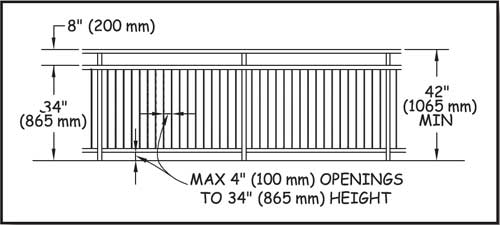Railings—Guardrails, Handrails, and Safety
Accessibility never supersedes the requirements for safety. This issue most commonly arises at overlook areas, on viewing structures, and in similar locations. For safety, the International Building Code (IBC), http://www.iccsafe.org, section 1003.2.12 contains requirements for guardrail height and the spacing of rails where there is a drop off of 30 inches or more. These requirements provide opportunities for creative design and for managers and designers to think seriously about the level of development that is appropriate for the setting. The creativity challenge is to provide safety when designing the railing or structure adjacent to the drop off, while maximizing viewing opportunities. Methods of solving this challenge are discussed in "Viewing Areas" of this guidebook.
Reconsidering the level of development at a site may be another way to balance safety and accessibility issues. It may not always be appropriate to provide paths and interpretive signs. When signs indicate a scenic viewpoint and a pathway begins at the parking lot, visitors are likely to stop, pile out of their vehicle, and head down that pathway, often with the children running ahead. Because of the high level of development at the entrance to the pathway, visitors expect that the viewpoint will have a similar high level of development, including safety features. Development should be consistent at both ends of the pathway.
If the area isn't developed, such as a waterfall in the forest with no signs or constructed trail to it, it may not be appropriate to develop a viewpoint. Some scenic areas should remain natural so that people have the opportunity of adventure and solitude. The safety and accessibility requirements only apply when constructed features are added to the setting.
While the accessibility guidelines for outdoor recreation areas do not require handrails at stairs, consider the safety of the people using the stairs and the setting when deciding whether handrails are appropriate. What is the expected amount of use? The determination must be made on a case-by case basis. For example, a handrail might not be necessary where there are a few regularly spaced stairs to an individual camping unit. However, handrails on stairs in a high-traffic recreation site may be important for safe use of the stairs. If the decision is made to install handrails at a recreation site, consider how the appearance of over development can be avoided while providing for safe use of the stairs. Choose materials carefully; determine how many railings will be provided based on safety considerations rather than convention, and so forth. When it is determined handrails are needed for safety at a specific site in an outdoor recreation area, use the technical requirements for handrails located in ABAAS, section 505.
Terminology Tip
What's the difference between a guardrail, a handrail, and a grab bar?
The following explanations of terms are based on the International Building Code and the Architectural Barriers Act Accessibility Standards. Keep these explanations in mind and use them to communicate more effectively.
-
Guardrails protect people from dropoffs higher than 30 inches (760 millimeters). Guardrails must be at least 42 inches (1,065 millimeters) high. If the guardrail has openings that are less than 34 inches (865 millimeters) above the walking surface, they must be small enough to prevent a 4-inch (100-millimeter) sphere from passing through them (figure 15). Requirements for guardrails are detailed in the International Building Code, section 1003.2.12.
-
Handrails provide a steady support for persons who are going up or down stairs or inclines. Handrails must be between 34 inches (865 millimeters) and 38 inches (965 millimeters) above the walking surface and be easy to grip. Details about acceptable configurations for handrails are provided in the International Building Code, section 1003.3.3.11 and in the Architectural Barriers Act Accessibility Standards, section 505.
-
Grab Bars provide stability and allow people to use their arms to help them move short distances. The most common location for grab bars is in restrooms. The required locations of grab bars are explained in the Architectural Barriers Act Accessibility Standards, chapter 6. Details about grab bar configuration and attachment are provided in the Architectural Barriers Act Accessibility Standards, section 609 and in the International Building Code, chapter 11.

Figure 15— Dimensions required for guardrails.

User Comments/Questions
Add Comment/Question